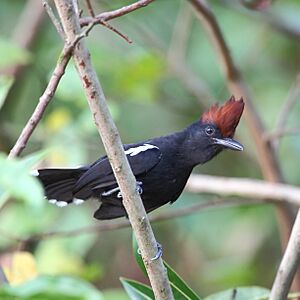Glossy antshrike facts for kids
Quick facts for kids Glossy antshrike |
|
|---|---|
 |
|
| Female at Apiacás river, Mato Grosso state, Brazil | |
| Conservation status | |
| Scientific classification | |
| Genus: |
Sakesphorus
|
| Species: |
luctuosus
|
 |
|
The glossy antshrike (Sakesphorus luctuosus) is a cool bird found only in Brazil. It belongs to a group of birds called "typical antbirds." These birds are known for living in forests and eating insects.
Contents
About the Glossy Antshrike's Family Tree
Scientists who study birds, called ornithologists, often group animals together. This helps us understand how different species are related. For the glossy antshrike, its family tree is still a bit of a puzzle!
Some scientists think there are two types, or "subspecies," of glossy antshrikes. Others believe there's only one main type. This is because the small differences they see might just be gradual changes across the bird's home area. A study in 2012 even suggested that one group of these birds might be a totally separate species! For now, we'll focus on it as one main species.
What Does the Glossy Antshrike Look Like?
The glossy antshrike is about 17 centimeters (about 6.7 inches) long. It weighs between 27 and 33 grams (about 1 ounce). Both male and female birds have a fluffy crest on their heads.
Male and Female Differences
Male glossy antshrikes are almost completely black. Their lower back, rump, and lower belly are dark gray. They have some white feathers hidden under their wings and white tips on their tail feathers. The amount of white can be a little different depending on where the bird lives.
Female glossy antshrikes look a lot like the males. However, they have a deep chestnut-brown color on their forehead and crest. Young males look like adult females, but they usually have some black feathers in their crest.
Where Does the Glossy Antshrike Live?
The glossy antshrike lives in a large part of the Amazon Basin in Brazil. You can usually find it along the main Amazon river and the rivers that flow into it from the south. Its home range stretches across several Brazilian states.
Preferred Habitat
This bird likes forests and woodlands near rivers and smaller streams. It especially likes areas called igapó and várzea forests, which are often flooded. It can also be found in places that don't flood very often. Sometimes, it lives on islands within the larger rivers.
Glossy antshrikes prefer the lower and middle parts of the forest. They like areas with lots of shrubs and climbing plants. They live from sea level up to about 250 meters (about 820 feet) high.
Glossy Antshrike Behavior
Movement
The glossy antshrike is thought to stay in the same area all year round. It does not seem to migrate.
Feeding Habits
The glossy antshrike eats many different kinds of insects and other small creatures like spiders. It usually looks for food alone or with its mate. Sometimes, it might join a group of different bird species feeding together.
It typically searches for food from the ground up to about 15 meters (about 49 feet) high. It hops through thick plants, picking up prey from leaves, stems, vines, and branches. It can reach for food or even make short jumps from a branch. Sometimes, it will drop to the ground to catch something.
Reproduction and Life Cycle
Scientists have only found one glossy antshrike nest so far. It was discovered in December and had baby birds inside. The nest was shaped like a hanging bag, made from plant fibers and a few leaves. It was hanging from the top of a tree, about 3 meters (about 10 feet) above the ground. This tree was the only one on a small river island. Both parent birds helped feed the babies. We don't know how long the eggs take to hatch or how long the babies stay in the nest.
Vocalization
The glossy antshrike's song is a quick series of 10 to 15 high, nasal "ah" notes. It also makes other sounds, like slow, repeated, downward-sloping whistles. It can make soft, raspy "caw" notes, a long downward-sloping whistle, and a shorter whistle that quickly turns into a rattling sound.
Status and Conservation
The IUCN (International Union for Conservation of Nature) has listed the glossy antshrike as a species of "Least Concern." This means that it is not currently in danger of disappearing. It lives in a very large area. While its exact population size isn't known, it's thought to be decreasing. However, no immediate threats have been found.
This bird is generally considered common. There is a lot of suitable habitat for it in its range. Some of these areas are protected in private nature preserves and national parks. Because it relies on flooded forests, it's less likely to be disturbed by human activities. Also, it can move into disturbed areas with new plant growth, which suggests it's not very sensitive to changes in its environment.


